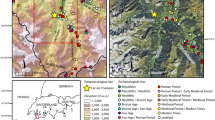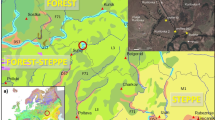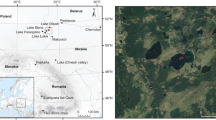Abstract
Late Holocene pollen and sediment records from the Lake Tauanui catchment, northern New Zealand, indicate that the lake formed about 5500 years ago following a series of volcanic events in the Tauanui Volcanic Centre. These volcanic events initiated a volcanosere resulting in a mixed conifer-hardwood forest. Dacrydium cupressinum was the dominant tree. Agathis australis was always present. Changes similar to those registered in other Northland pollen diagrams are apparent. At ca 4000 yr B.P., when the climate became cooler and drier than before, a fire occurred in the catchment area causing erosion of the surrounding slopes and some destruction of forest. Fluctuations in abundance of many forest species, including Ascarina lucida, A. australis and D. cupressinum, from ca 3500 yr B.P. indicate repeated disturbance, increasingly so after 1600 yr B.P. Summer droughts and increased frequency of cyclonic winds are suggested as the cause. Major anthropogenic deforestation events defined by palynology occurred across many parts of the New Zealand landscape at ca 700 yr B.P. At Lake Tauanui anthropogenic forest disturbance, radiocarbon dated to ca 1000 yr B.P., is indicated by significant decline in all tree and shrub elements with concomitant increase in pteridophytes, especially Pteridium esculentum. Charcoal concentration increases steadily from the onset of disturbance, and in the final phase after the arrival of Europeans, major clearance of vegetation is indicated. Herbs increase markedly in this period, in diversity and abundance.
Similar content being viewed by others
References
Allan, H. H., 1961. Flora of New Zealand. Vol. 1. Government Printer, Wellington, 1085 pp.
Anderson, A. J., 1991. The chronology of colonisation in New Zealand. Antiquity 65: 767–795.
Brownsey, P. J. & J. C. Smith-Dodsworth, 1989. New Zealand Ferns and Allied Plants. David Bateman, Auckland, 168 pp.
Burrows, C. J., 1990. Processes of Vegetation Change. Unwin Hyman, London, 551 pp.
Bush, M. B., D. R. Piperno, P. A. Colinvaux, P. E. De Oliveira, L. A. Krissek, M. C. Miller & W. L. Rowe, 1992. A 14 300year palaeoecological profile of a lowland tropical lake in Panama. Ecol. Monogr. 62: 251–276.
Bussell, M. R., 1988. Mid and late Holocene pollen diagrams and Polynesian deforestation, Wanganui district, New Zealand. N. Z. J. Bot. 26: 431–451.
Chester, P. I., 1986. Forest Clearance in the Bay of Islands. Unpublished MA thesis, Department of Anthropology, University of Auckland, 359 pp.
Connor, H. E. & E. Edgar, 1987. Name changes in the indigenous New Zealand flora, 1960-1986 and Nomina Nova IV, 1983-1986. N. Z. J. Bot. 25: 115–170.
Davidson, J., 1984. The Prehistory of New Zealand. Longman Paul, Auckland, 270 pp.
Dodson, J. R., N. J. Enright & R. F. McLean, 1988. A late Quaternary vegetation history for far northern New Zealand. J. Biogeogr. 15: 647–656.
Elliot, M. B. & V. E. Neall, 1996. The age and origins of Lake Tauanui, Northland, New Zealand. Geol. Soc. N. Z. Newsl. 111: 36–39.
Elliot, M. B., B. Striewski, J. R. Flenley & D. G. Sutton, 1995. Palynological and sedimentological evidence for a radiocarbon chronology of environmental change and Polynesian deforestation from Lake Taumatawhana, Northland, New Zealand. Radiocarbon 37: 899–916.
Enright, N. J., R. F. McLean & J. R. Dodson, 1988. Late Holocene development of two wetlands in the Te Paki region, far northern New Zealand. J. r. Soc. N. Z. 18: 369–382.
Fægri, K. & J. Iversen, 1989. Textbook of Pollen Analysis, 4th ed. John Wiley, Chichester, 328 pp.
Flenley, J. R., 1994. Pollen in Polynesia: the use of palynology to detect human activity in the Pacific islands. In Hather, J. G. (ed.), Tropical Archaeobotany: applications and new developments. Routledge, London: 202–214.
Flenley, J. R. & K. Richards (eds), 1982. The Krakatoa centenary expedition. Final report. Department of Geography, University of Hull Miscellaneous Series, 25.
Grimm, E. C., 1987. CONISS: A FORTRAN 77 programme for stratigraphically constrained cluster analysis by the method of incremental sum of squares. Comp. Geosci. 13: 13–35.
Grimm, E. C., 1991a. Tilia version 1.12. Research and Collections Centre, Illinois State Museum.
Grimm, E. C., 1991b. Tiliagraph version 1.18. Research and Collections Centre, Illinois State Museum.
Kershaw, A. P.& K.M. Strickland, 1988. A Holocene pollen diagram from Northland, New Zealand. N. Z. J. Bot. 26: 145–152.
McFadgen, B. G., F. B. Knox & T. R. L. Cole, 1994. Radiocarbon calibration curve variations and their implications for the interpretation of New Zealand prehistory. Radiocarbon 36: 221–236.
McGlone, M. S., 1978. Forest destruction by early Polynesians, Lake Poukawa, Hawkes Bay, New Zealand. J. r. Soc. N. Z. 8: 275–281.
McGlone, M. S., 1983. Polynesian deforestation of New Zealand: a preliminary synthesis. Archaeol. Oceania 18: 11–25.
McGlone, M. S., 1988. New Zealand. In Huntley, B. & T. Webb III (eds), Vegetation History. Kluwer Academic, Dordrecht: 557–599.
McGlone, M. S., 1989. The Polynesian settlement of New Zealand in relation to environmental and biotic changes. N. Z. J. Ecol. 12: 115–129.
McGlone, M. S. & N. T. Moar, 1977. The Ascarina decline and postglacial climatic change in New Zealand. N. Z. J. Bot. 15: 485–489.
McGlone, M. S., M. J. Salinger & N. T. Moar, 1993. Paleovegetation studies of New Zealand' climate since the Last Glacial Maximum. In Wright, H. E., J. E. Kutzbach, T. Webb III, W. F. Ruddiman, F. A. Street-Perrott & P. J. Bartlein (eds), Global Climates since the Last Glacial Maximum. University of Minnesota Press, Minneapolis: 294–317.
]McGlone, M. S., A. F. Mark & D. Bell, 1995. Late Pleistocene and Holocene vegetation history, Central Otago, South Island, New Zealand. J. r. Soc. N. Z. 25: 1–22.
McGlone, M. S., D. C. Mildenhall & M. S. Pole, 1996. History and palaeoecology of New Zealand Nothofagus forests. In Veblen, T. T., R. S. Hill & J. Read (eds), The Ecology and Biogeography of Nothofagus Forests. Yale University Press, New Haven: 84–130.
Mildenhall, D. C., 1976. Exotic pollen rain on the Chatham Islands during the Late Pleistocene. N. Z. J. Geol. Geophys. 19: 327–333.
Mildenhall, D. C., 1979. Holocene pollen diagrams from Pauatahanui Inlet, Porirua, New Zealand. N. Z. J. Geol. Geophys. 22: 585–591.
Moar, N. T., 1970. Recent pollen spectra from three localities in the South Island, New Zealand. N. Z. J. Bot. 8: 210–221.
Moir, R. W., B. Collen & C. S. Thompson, 1986. The climate and weather of Northland, New Zealand. Met. Serv. Misc. Pub. 115 (2nd ed.), 37 pp.
Molloy, B. P. J., 1969. Evidence for postglacial climatic changes in New Zealand. J. Hydrol. 8: 56–67.
Molloy, B. P. J., 1995. Manoao (Podocarpaceae), a new monotypic conifer genus endemic to NewZealand. N. Z. J. Bot. 33: 183–201.
Moore, L. B. & E. Edgar, 1976. Flora of New Zealand, Vol. II. Government Printer, Wellington, 354 pp.
Newnham, R. M., 1992. A30 000 year pollen, vegetation and climate record from Otakairangi (Hikurangi), Northland, New Zealand. J. Biogeogr. 19: 541–554.
Newnham, R. M., P. J. de Lange & D. J. Lowe, 1995. Holocene vegetation, climate and history of a raised bog complex, northern New Zealand based on palynology, plant macrofossils and tephrochronology. Holocene 5: 267–282.
Pennington, W., R. S. Cambray, J. D. Eakins & D. D. Harkness, 1976. Radionuclide dating of the recent sediments of Blelham Tarn. Fresh. Bio. 6: 317-331.
Richards, P. W., 1964. The tropical rain forest. An ecological study, 2nd reprint. Cambridge University Press, Cambridge, 450 pp.
Stockmarr, J., 1971. Tablets with spores used in absolute pollen analysis. Pollen Spores 13: 615–621.
Stuiver, M. & H. A. Polach, 1977. Discussion: reporting of 14C data. Radiocarbon 19: 355–363.
Sutton, D. G., 1994. Conclusion: Origins. In Sutton, D. G. (ed.) The Origins of the First New Zealanders, Auckland University Press, Auckland: 243–258.
Taylor, B. W., 1957. Plant succession on recent volcanoes in Papua. J. Ecol. 45: 233–243.
Tomlinson, A. I., 1975. Structure of the wind over New Zealand. N.Z. Met. Serv. Tech. Inf. Circ. 147.
Tröoels-Smith, J., 1955. Karakterisering af løose jordater. Dan. Geol. Unders. Ser. IV 3: 73 pp.
Walker, D., 1964. A modified Vallentyne mud sampler. Ecology 45: 642–644.
Wardle, P., 1991. Vegetation of New Zealand. Cambridge University Press, Cambridge, 672 pp.
Author information
Authors and Affiliations
Rights and permissions
About this article
Cite this article
Elliot, M.B., Flenley, J.R. & Sutton, D.G. A late Holocene pollen record of deforestation and environmental change from the Lake Tauanui catchment, Northland, New Zealand. Journal of Paleolimnology 19, 23–32 (1998). https://doi.org/10.1023/A:1007921021661
Issue Date:
DOI: https://doi.org/10.1023/A:1007921021661




